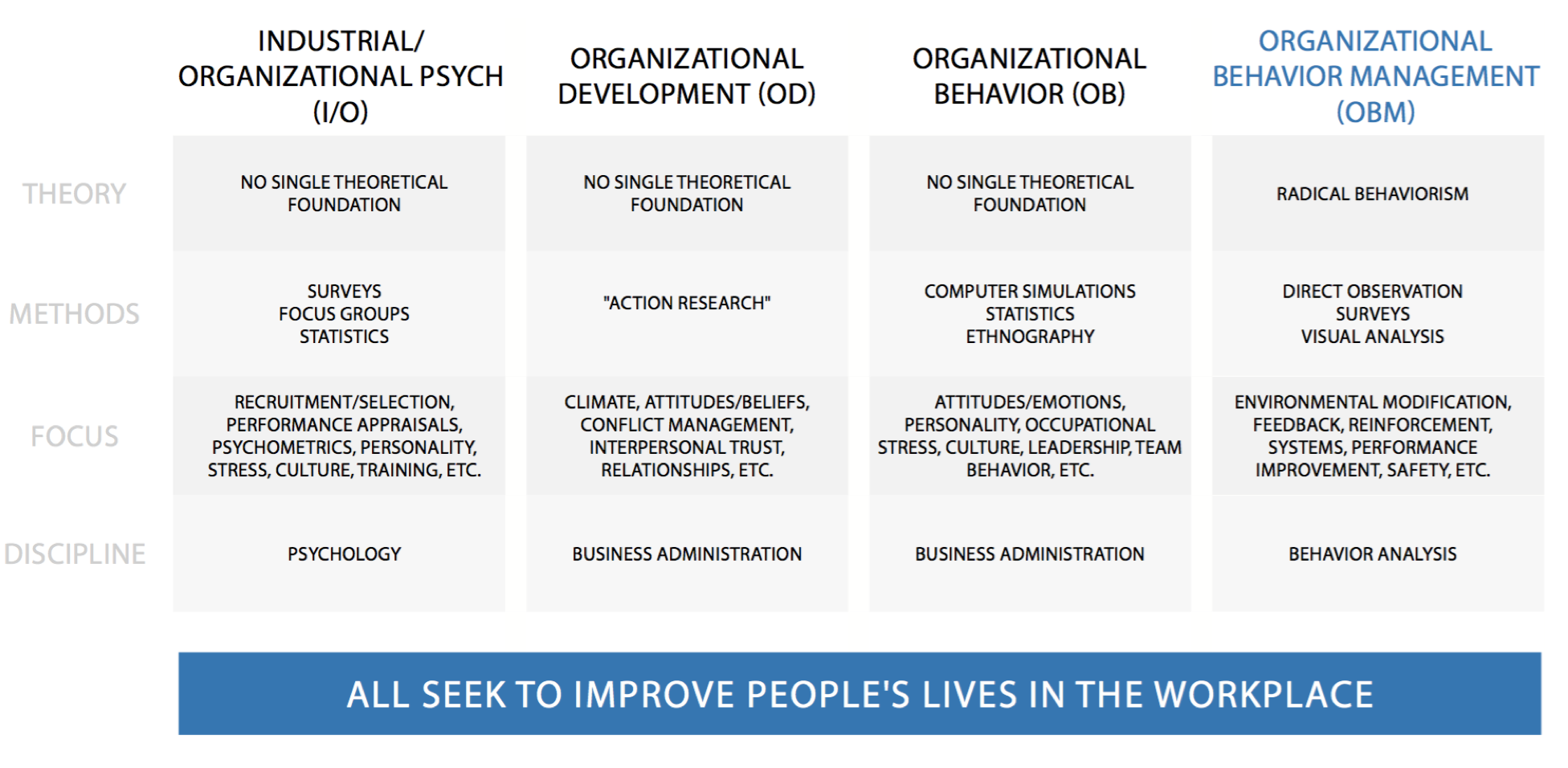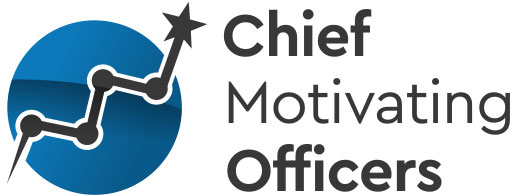What is Organizational Behavior Management?
Before you get to know us at CMO, you should get to know our foundational science: Organizational Behavior Management. In plain language, organizational behavior management, or OBM, is the science of human behavior applied in work settings, with the goal of improving human performance and achieving significant business outcomes for the organizations in which the strategies are being implemented.
“It’s all the same science!”
If you have heard of the field of Behavior Analysis, then you are familiar with some of the concepts and principles that drive our work:
- Clear operational definitions, or “pinpoints”
- Environmental modification, or the “ABCs”
- Functional assessments, which help us find the root cause of issues
- Reinforcement of desired behavior
- Reduction and replacement of less-desired behavior
- Social validity and sustainability
- And the use of data in everything that we do!
While OBM didn’t really get its wings until the 1970s, when Dr. Aubrey Daniels began the Journal of Organizational Behavior Management, applications of Behavior Analysis in various businesses and industries were already happening! Check out the father of Behavior Analysis, Dr. B.F. Skinner, discussing his work in implementing interventions in the logistics industry in this 1972 documentary called Business, Behaviorism, and the Bottom Line…
...but isn't that [insert other discipline here]?"
At a surface level, you may think we are very similar to other social/psychological sciences – Industrial/Organizational Psychology, Organizational Development, or (most confusingly) Organizational Behavior. But this is a super common misconception! Check out this table we created below which highlights some of the major differences between these disciplines.

Applications of OBM
So, what is it that OBM practitioner’s actually do? Here are just some of the important sub-disciplines in OBM, and some resources for learning more about each.
Performance Management
This is what people classically refer to as OBM, but it is actually just one subdivision of practice in our field. The focus of PM, as it is affectionately called, is typically individual-performer focused – looking at an employee’s antecedents, behaviors, and consequences to determine individualized interventions to improve performance. Dr. Aubrey Daniels is the father of PM, and provides a wide range of resources and support for learning about this big subset of OBM practice.
Behavioral Systems Analysis
This area, known as BSA for short (we certainly love our acronyms), “zooms out” from the individual performer and focuses much more heavily on the entire organizational system. We often sort our analyses into three levels:
- Organization – mission, vision, values, structure, and high-level measurement and monitoring systems
- Process – how things get done, how different departments/individuals interface with one another,etc.
- Job/Performer – similar to classic performance management, focused on individual employee experience, measures, barriers, and more
Dr’s. Heather McGee and Lori Ludwig are two major players in this space, and have authored some of the best user-friendly literature and tools that make this area of practice more attainable for everyday leaders and consultants.
Behavior-Based Safety
BBS (again with the acronyms) is the application of behavior science to safety behaviors, typically in highly hazardous industries, such as manufacturing, chemical processing, construction, mining, and countless others. Getting employees to continue to engage in behaviors like wearing protective equipment or effortful practices that make their work take longer is difficult, because the consequences of being unsafe don’t always result in injury or punishment. BBS practitioners influence leader behavior that leads to more safe teams, even when the boss isn’t watching.
Dr. Tim Ludwig is a very active practitioner, speaker, and author who is changing the world through his BBS work.
Consumer Behavior Analysis
Consumer behavior analysis is an amazing application of OBM and general behavior analytic strategies designed to influence buyer behavior. Practitioners in this area have expanded our traditional ABC paradigm to answer the question: why do people purchase what they do? These practitioners are found in marketing firms or departments, but can make huge impacts in organizations seeking to improve healthy food choices, reduce carbon emissions, and more.
Dr. Gordon Foxall is a major driving force in this space, with massive studies occurring in the UK on purchasing behaviors of tens of thousands of families.
Training and Talent Development
While this is a sub-area within others listed here, it deserve a note of its own because of the prominence of OBM practitioners in this area. Behavior analysis, after all, is the science of learning, and OBM practitioners use exceptional instructional design strategies to create observable and measurable change in behavior through training programs.
Dr. Barbara Bucklin is an exceptional instructional designer that has worked in major corporations to help design and evaluate their training and development programs.
Other Application Areas
OBM practitioners also have major roles to play in change management, culture change, process improvement, executive coaching, leadership training, strategic planning, project management, and other critical operations roles within organizations. It is an incredibly wide area of practice, with many interesting applications and strategies!
Industries in which OBM is used
Applications of OBM are occurring in many industries, believe it or not! Here is a list of just a few research studies that demonstrate the reach of OBM practitioners:
- Human services (Gravina et al, 2018)
- Manufacturing (Blasingame, Hale, & Ludwig, 2014)
- Health and wellness (Bowles, Malott, & Dean, 2008)
- Telecommunications (Tilka & Johnson, 2017)
- Finance (McNally & Abernathy, 1989)
- Education (Phillips, 2008)
- Healthcare (Kelley & Gravina 2017)
- Non-profits (Biglan, 2008)
- Governments (Nordstrom, Lorenzi, & Hall, 1991)
- Utilities (Clayton & Nesnidol, 2017)
- Mining (Hagge, McGee, Matthews, & Aberle, 2016; Rhoton, 2008)
- Hospitality (Smith, 2010; LaFleur & Hyten, 1995)
- Transportation and logistics (Hickman and Gellar, 2008; Goomas, 2012)
- Retail (Rafacz, Boyce, & Williams, 2010)
- … and so many more!
Common Misconceptions
There are many myths and misconceptions about the practice of OBM. We have created the infographic here to highlight some of them, and educate people on the reality of what we do!
OBM Is…
Hard Science
OBM focuses on only what is observable and measurable, and uses the scientific method and hard data to ensure our practices are empirically validated and scientifically sound.
OBM Is NOT…
Soft Science
OBM does not typically focus on internal states, personality traits, or anything that can’t be observed by multiple individuals. OBM is not only based upon correlation like many softer sciences, such as psychology.
Behavior Analysis
OBM is the application of BF Skinner’s radical behaviorism and the science of human behavior in organizational contexts. OBM spans across many industries and many applications, but always focuses on its root scientific foundation.
I/O – OD – OB
While we work alongside practitioners in these other areas, we are not them. These programs are often housed in business schools, use group-design methodology, don’t have the same theoretical and philosophical foundation, and focus on different objects of study, like personality and hiring practices.
Individualized
Although often used to impact group behavior, OBM practitioners will also ensure that the performance of each individual is increasing. Performance varies for different reasons for everyone.
Only Group-Focused
Using the mean of a group does not guarantee individual performance has been increased, and you can lose important individual differences by focusing on data in large groups.
Very Diverse
Specialty areas within OBM include, and are not limited to: performance management, behavior-based safety, behavioral systems analysis, change management, and consumer behavior analysis.
Just Performance Management
PM is a big area for OBM practitioners to work within, but there is more to the science than just improving individual performance alone, and those other areas are definitely worth studying.
Diagnostic
Performance diagnostics, preference assessments, and functional behavior assessments are important tools for OBM practitioners to ensure we are using the right interventions to improve performance.
One-Size-Fits-All
Often, individuals will default to training as the solution for performance problems at work; however, without a proper analysis, we may be implementing expensive trainings for nothing.
Data-based
OBM practitioners use data to guide every aspect of their work: which interventions to implement, whether they’re effective or should change, and whether they sustain over time.
Set-and-Forget
OBM practitioners do not put an intervention in place and leave. Without appropriate data collection and follow-up, initiatives often become “flavor of the month” and will not maintain.
Sustainable
When implementing change, the OBM practitioner builds interventions for lasting change. This includes transitioning the tasks to internal team members, training leaders to reinforce behavior around the change, and developing systems and processes to ensure the changes maintain after they leave.
Quick Fix
In order to be sustainable, the changes that OBM practitioners implement take work, buy-in, time, and patience. OBM interventions are often not “quick fixes”, which are implemented without proper analysis, diagnostics, and research to make sure the right interventions are in place and the right people are involved.
Socially Valid
Social significance is a huge aspect of behavior analysis, and in OBM it’s no different. The interventions we implement should be to encourage change that is important to the organization, to the stakeholders, and most importantly, to the employees. OBM practitioners want to ensure that what we do is reinforcing to all involved.
Profit-centric
OBM practitioners do not just implement whatever changes the highest bidder is looking to enact. We have an ethical obligation to not focus only on increasing the performance of employees that lead to the highest bottom line, especially not at the expense of employee satisfaction and safety, as well as on society, the environment, and the world.
Complex
OBM practitioners often have years of formal training and/or experience. There are entire degree programs devoted to learning how to apply this science.
Simple
One course or reading or experience in OBM is likely not enough for one to be an effective practitioner, and mentorship is HIGHLY advised for newcomers.
Is that all? No way!
We hope this has been a nice, short introduction to what Organizational Behavior Management is. There is SO much more out there, so check out our blog and the links and resources below for more information.
- The OBM Network – The largest OBM professional development organization and a special interest group of the Association for Behavior Analysis International
- The OBM/Management Skill Share Facebook Group – An informal group of practitioners, from beginners to advanced, that share resources, information, and answer questions openly, moderated by CMO
- The OBM Reading Club – A free, once-per-month reading group hosted by CMO, in which applied articles are shared from a wide range of authors on a variety of topics, and with a focus on application and discussion
Want more information? Get a hold of us!
We're here to answer your questions on all things OBM.
